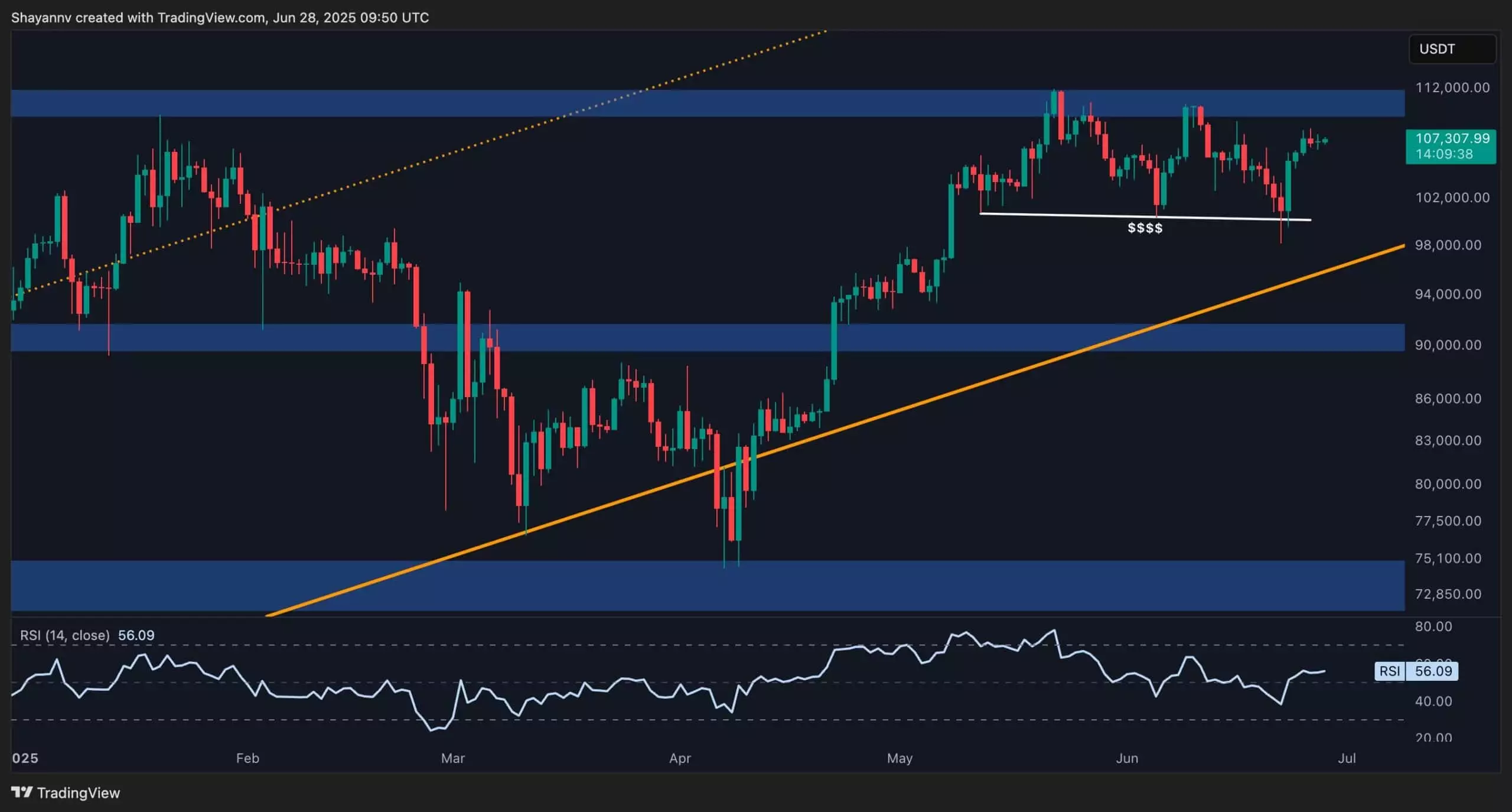Bitcoin’s recent price behavior near the $111K mark — its all-time high (ATH) — reveals a more precarious situation than the usual bullish chatter suggests. The cryptocurrency has repeatedly faltered at this psychologically and technically significant resistance, exposing a growing vulnerability in its upward momentum. Despite the optimism from many market participants anticipating a swift breakout above this level, the recurring selling pressure and profit-taking around this price point highlight an uncomfortable truth: Bitcoin’s rally is losing steam and faces genuine risk of rejection. This is not a classic bull run’s effortless climb; instead, it’s a sideways tug-of-war marked by hesitation and diminishing buyer conviction.
Such consolidation phases are common after parabolic advances, but the current stall underlines a deeper market uncertainty. Even after dipping below the $100K support briefly — a move that some interpret as a liquidity sweep intended to shake out weak hands — Bitcoin’s rebound to around $107K has proven tepid, lacking the vigor one would expect if a strong breakout were imminent. This pattern illustrates the limits of optimism detached from robust demand, which, if not renewed soon, might tilt the scales in favor of bears.
Technical Nuance: The Bullish Flag’s Fragility
The technical formation underpinning Bitcoin’s current price action—a bullish flag below the $111K resistance—is traditionally considered a continuation pattern that foretells further upward movement. However, no technical signal guarantees success; context matters immensely. The flag’s low-volatility phase near resistance points to a significant loss of momentum, implying buyers are hesitant rather than aggressive. While the liquidity grab below the $100K boundary provided short-term fuel, such maneuvers can also indicate manipulation or strategic positioning by market makers rather than genuine, broad-based investor enthusiasm.
If Bitcoin can indeed push through $111K soon, it would require a measurable surge in buying volume to overcome the entrenched supply. Without such demand, the probability of a breakdown from this flag formation increases, potentially dragging prices back toward the $100K support level. Investors should be wary of double tops and false breakouts—classic traps in volatile asset markets where emotional exuberance can swiftly morph into disappointment.
The Significance of Declining Exchange Reserves
On-chain metrics introduce another layer of complexity. Data from CryptoQuant points to a notable reduction in Bitcoin held on centralized exchanges, marking some of the lowest reserves in years. At first glance, this is good news for Bitcoin proponents: it signals that investors are increasingly opting for self-custody over holding assets on exchanges, reducing the immediate selling pressure from easy-access liquidity pools. In theory, this slow supply churn on exchanges could precipitate supply shocks if demand suddenly spikes, pushing prices much higher.
However, this structural trend should not be conflated with short-term bullish momentum. Lower exchange reserves underpin Bitcoin’s long-term narrative of scarcity and accumulation, but do not guarantee instant price rallies. If market sentiment sours, and broader macroeconomic or technical headwinds prevail, the diminished sell-side supply might evaporate as holders choose to liquidate via decentralized avenues or other mechanisms. Thus, while promising, these patterns are not fail-safe signals of imminent price surges.
Market Psychology and the Role of Demand
What ultimately determines Bitcoin’s trajectory over the coming days and weeks is demand intensity. The cryptocurrency community often falls into wishful thinking, mistaking steady accumulation for sustained buying pressure. Confidence alone does not move markets; demand must translate into concrete transactions at scale. Currently, the lack of a decisive influx of buyers above $111K tells us that many investors remain cautious, possibly waiting on macroeconomic clarity—such as inflation figures or regulatory developments—before committing more capital.
This restraint from buyers mirrors a center-right liberal perspective on market behavior: rational actors respond cautiously to new information, rewarding assets that prove resilient to external shocks rather than speculative froth. Bitcoin’s price resilience near $100K to $110K zones is promising, but it is not untouchable. The market is signaling that it requires substantiated growth, not hype-driven momentum, and any misstep could trigger a sharp correction, reinforcing the need for measured, fundamental-driven investment approaches.
The Persistent Shadow of Macro and Technical Risks
Finally, while enthusiasts focus on Bitcoin’s technical setups and on-chain fundamentals, one must not underestimate the influence of broader macroeconomic and technical risks. Elevated political tensions, central bank policies, and systemic economic uncertainties could quickly overwhelm the fragile bullish setup. Moreover, from a technical trading standpoint, repeated failures near major resistance can erode confidence and ignite cascading stop-loss liquidations, accelerating declines before any recovery can initiate.
Bitcoin’s current phase resembles a lit fuse waiting for the right catalyst. But unlike some exaggerated forecasts, the trajectory is not guaranteed to be upwards. Investors who rigidly cling to bullish narratives blind to the subtle but growing internal vulnerabilities do so at their own peril. Prudent market participants recognize the looming crossroads and prepare accordingly, balancing optimism with discipline amid the cryptocurrency’s ongoing volatility.
















Leave a Reply